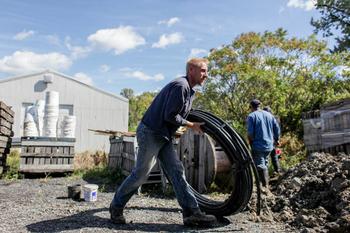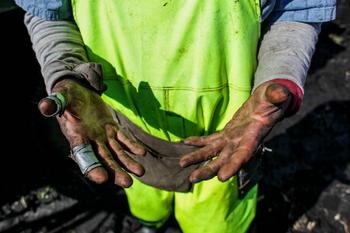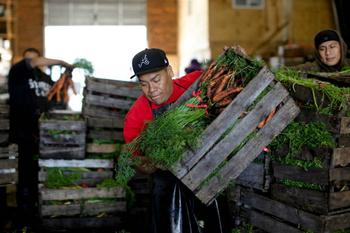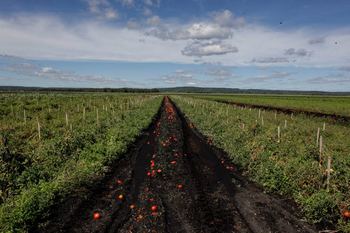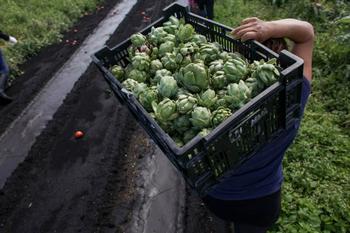Thanksgiving is the ultimate harvest holiday, and no one knows that better than the tens of thousands of farm workers who grow and harvest New York’s produce.The reality of agriculture is that a hefty percentage of the people who plant and harvest New York’s local food are immigrant workers, many of whom put themselves in danger to cross the border into the United States to work the land.
In New York, farm workers labor long hours with no overtime pay and no right to a day of rest. Nor do they have the right to collective bargaining — something Cesar Chavez fought for fifty years ago. But that was in California, and those labor laws don’t cross state lines into New York.
Antonio Valeriano is originally from Oaxaca, and now works at a farm in the Hudson Valley. “We wake up at five in the morning, because we need to be at work by six. In the morning.” He’s often works until 8 at night, and as late as 10 p.m. when the harvest is at its busiest.
He’s part of a crew of twelve men who spend the day tending the fields. When the sun goes down, they move to the packing house, where bruised fruit is turned to cider, and the produce of the day is washed, bunched and prepped for market.
Like many farm workers, they live in a grower-provided labor camp — which on this farm means a run-down old house on the property where they sleep three to a room.

(Photo: Antonio Valeriano and the other men at the farm spend some of their free time working on puzzles they buy during trips to WalMart. Courtney Dudley for WNYC)
When they get back to the house, the men cook dinner in shifts. “Something that we can put together quickly. More than anything we want to rest. So we don’t cook anything very complicated. So, fast food,” Valeriano explained.
For dinner, they are warming tortillas, cans of tomato sauce and shrimp-flavored cup-of-noodles.
Valeriano admitted the work is hard, "and we almost never rest,” but he isn’t complaining. “Like I said, we don’t consider this work, we don’t think of it that way. We like doing this.” Giving a tour of the grounds and the packing house across the driveway, he’s clearly proud of what he does.
Gerardo Gutiérrez, an attorney working with the Rural Migrant Ministry in Poughkeepsie, is campaigning to remove the exclusions that keep New York farm workers from having the same rights as all other New York State workers. “This is an issue that is not only a human rights issue, it’s a labor issue, it’s a moral issue. No matter how you slice it, this issue is a no-brainer because we need to give these people some rights, ” he said.
Gutierrez says farm workers work 60 to 80 hours, sometimes seven days a week. The farm workers are often happy to work the extra hours but the no-overtime pay provision means that they don’t get time and a half after 40 hours. He points out that growers are capitalizing on labor that’s not being fully compensated.
The campaign for farm worker’s rights has met with opposition from the New York Farm Bureau, the organization that represents farmer’s interests. While they support the right to a day of rest, they believe that the right to overtime pay and the right to collective bargaining isn’t appropriate for the seasonal nature of New York agriculture. Instead they are focusing on the big picture of immigration reform, which they believe will improve the lives of farm workers and the growers they work for.
(Photo: A worker takes in a crate of produce from the fields at Glebocki farms. Courtney Dudley for WNYC)
John Glebocki is a fifth generation farmer in the fertile Black Dirt region of Orange County, New York. His ancestors originally broke up the dirt back in the 1880s, and he and his crew farm 120 acres of land. Unlike Valeriano, he has a larger team of workers, who only work about 8 hours a day, depending on the harvest.
He has stands in 21 farmer’s markets in the city. Depending on the season, he’s selling vegetables like lacinato kale, kirby cucumbers, hardneck garlic, frying peppers, hot peppers, parsnip, zebra eggplants and purple carrots.
It’s the sort of locally-grown farmer’s market fare that New Yorkers demand. But this kind of multi-crop farming is labor intensive. He estimates that labor costs already make up about half of what he charges for any given vegetable.
Unlike the Farm Bureau, Glebocki supports the idea of overtime pay for his workers. He just doesn’t see how it can be economically viable.
“It all comes down to what the grower is getting for his product," he said. "You know if we were getting tremendous profit for what we sell, I'm sure we'd be able to offer more. But we can't.”
Glebocki calculates that either consumers will have to pay more for their vegetables, or tax breaks or other provisions have to be made for growers to offset the higher cost in labor.
Small- and medium-sized growers like Glebocki are at the heart of New York’s locally-grown food movement. It’s a group that Maggie Gray, a professor of political science at Adelphi University, has been researching for her book on labor and food ethics. She says that while consumers have demanded things like organic seeds and better treatment for farm animals, this merging of food and ethics hasn’t extended to farm workers. Gray relates a conversation she had with a small farmer.
“I asked him directly, I said 'why do you think it is that consumers seem so much more concerned about animals than they do about the workers themselves?' And without hesitation, he looked at me and he said ‘They don't eat the workers.’”
Immigrant farm workers subsidize the farm-to-table lifestyle with their labor, but they’re easy to ignore. There’s no quick solution that will allow growers to pay their workers higher wages or overtime. But those advocating for immigrant farm workers agree that like heirloom varieties, chemical-free practices, and local, fresh produce, worker’s rights will come at a cost. What they don’t know is if consumers are willing to pay the price.
Aurora Almendral comes to WNYC from Feet in 2 Worlds, a project of the Center for New York City Affairs at The New School.


